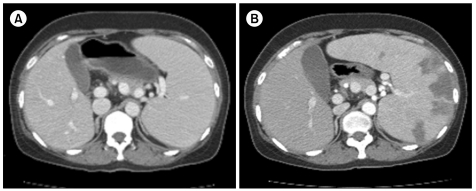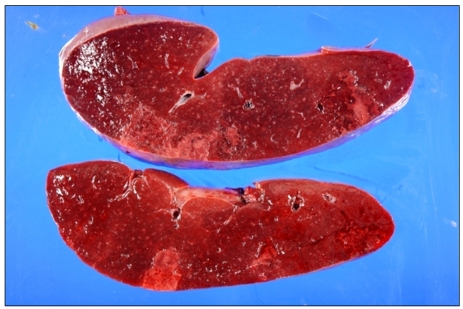Korean J Hematol.
2011 Dec;46(4):274-278. 10.5045/kjh.2011.46.4.274.
Splenic infarction in a patient with autoimmune hemolytic anemia and protein C deficiency
- Affiliations
-
- 1Division of Hematology/Oncology, Department of Internal Medicine, Inje University Ilsan Paik Hospital, Goyang, Korea. leehr@paik.ac.kr
- 2Department of Pathology, Inje University Ilsan Paik Hospital, Goyang, Korea.
- 3Department of Laboratory Medicine, Inje University Ilsan Paik Hospital, Goyang, Korea.
- 4Division of Hematology/Oncology, Department of Internal Medicine, Inje University Seoul Paik Hospital, Seoul, Korea.
- KMID: 2251989
- DOI: http://doi.org/10.5045/kjh.2011.46.4.274
Abstract
- Splenic infarction is most commonly caused by cardiovascular thromboembolism; however, splenic infarction can also occur in hematologic diseases, including sickle cell disease, hereditary spherocytosis, chronic myeloproliferative disease, leukemia, and lymphoma. Although 10% of splenic infarction is caused by hematologic diseases, it seldom accompanies autoimmune hemolytic anemia (AIHA). We report a case of a 47-year-old woman with iron deficiency anemia who presented with pain in the left upper abdominal quadrant, and was diagnosed with AIHA and splenic infarction. Protein C activity and antigen decreased to 44.0% (60-140%) and 42.0% (65-140%), respectively. Laboratory testing confirmed no clinical cause for protein C deficiency, such as disseminated intravascular coagulation, sepsis, hepatic dysfunction, or acute respiratory distress syndrome. Protein C deficiency with splenic infarction has been reported in patients with viral infection, hereditary spherocytosis, and leukemia. This is a rare case of splenic infarction and transient protein C deficiency in a patient with AIHA.
MeSH Terms
Figure
Reference
-
1. Antopolsky M, Hiller N, Salameh S, Goldshtein B, Stalnikowicz R. Splenic infarction: 10 years of experience. Am J Emerg Med. 2009; 27:262–265. PMID: 19328367.
Article2. Naithani R, Agrawal N, Mahapatra M, Pati H, Kumar R, Choudhary VP. Autoimmune hemolytic anemia in India: clinico-hematological spectrum of 79 cases. Hematology. 2006; 11:73–76. PMID: 16522555.
Article3. Eichner ER. Splenic function: normal, too much and too little. Am J Med. 1979; 66:311–320. PMID: 371397.
Article4. Horeau J, Robin C, Guenel J, Nicolas G. An unusual complication of acquired hemolytic anemia, splenic infarction. Concours Med. 1963; 85:663–666. PMID: 13961739.5. Tzanck A, Andre R, Dreyfus B. Acquired hemolytic anemia with infarct of the spleen; splenectomy; recovery. Bull Mem Soc Med Hop Paris. 1951; 67:286–290. PMID: 14831012.6. Khor B, Van Cott EM. Laboratory tests for protein C deficiency. Am J Hematol. 2010; 85:440–442. PMID: 20309856.
Article7. Farah RA, Jalkh KS, Farhat HZ, Sayad PE, Kadri AM. Acquired protein C deficiency in a child with acute myelogenous leukemia, splenic, renal, and intestinal infarction. Blood Coagul Fibrinolysis. 2011; 22:140–143. PMID: 21178585.
Article8. Olson JF, Steuber CP, Hawkins E, Mahoney DH Jr. Functional deficiency of protein C associated with mesenteric venous thrombosis and splenic infarction. Am J Pediatr Hematol Oncol. 1991; 13:168–171. PMID: 2069226.
Article9. Breuer C, Janssen G, Laws HJ, et al. Splenic infarction in a patient hereditary spherocytosis, protein C deficiency and acute infectious mononucleosis. Eur J Pediatr. 2008; 167:1449–1452. PMID: 18604554.
Article10. Troy K, Essex D, Rand J, Lema M, Cuttner J. Protein C and S levels in acute leukemia. Am J Hematol. 1991; 37:159–162. PMID: 1830452.
Article11. Suzuki Y, Shichishima T, Mukae M, et al. Splenic infarction after Epstein-Barr virus infection in a patient with hereditary spherocytosis. Int J Hematol. 2007; 85:380–383. PMID: 17562611.
Article12. van Hal S, Senanayake S, Hardiman R. Splenic infarction due to transient antiphospholipid antibodies induced by acute Epstein-Barr virus infection. J Clin Virol. 2005; 32:245–247. PMID: 15722031.13. Justo D, Finn T, Atzmony L, Guy N, Steinvil A. Thrombosis associated with acute cytomegalovirus infection: a meta-analysis. Eur J Intern Med. 2011; 22:195–199. PMID: 21402253.
Article
- Full Text Links
- Actions
-
Cited
- CITED
-
- Close
- Share
- Similar articles
-
- Acute Ischemic Stroke Showing Microembolic Signals in a Patient With Autoimmune Hemolytic Anemia
- Two Cases of Autoimmune Hemolytic Anemic
- A Case of Plasmodium vivax Malaria Associated with Autoimmune Hemolytic Anemia
- Two Cases of Autoimmune Hemolytic Anemia in Ulcerative Colitis
- A Case of Autoimmune Hemolytic Anemia after Fludarabine Treatment in Waldenstrom Macroglobulinemia



